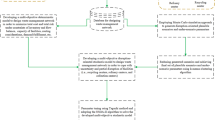Abstract
This article considers a two-level sustainable supply chain model with carbon emission under an uncertain/fuzzy environment. In most industries, setup costs are always considered an unnecessary expense, so in order to reduce that cost, many reduction (investments) strategies are studied in the literature. However, no research has been done to examine which investment strategy is most beneficial. Therefore, in this study, we have analyzed three different investment functions in three different cases. The main objective of this study is to maximize the total profit of the supply chain by optimizing the optimal values of the decision variables. Moreover, the product’s demand rate is considered a triangular fuzzy number to address the uncertainty. The centroid method is used for the defuzzification process. Five numerical examples and their discussions are given to evaluate the model. Finally, the managerial insights and conclusions with future directions are provided.





Similar content being viewed by others
Data availability statement
Data sharing not applicable to this article as no datasets were generated or analyzed during the current study.
References
Ammar, E.S., Emsimir, A.: A mathematical model for solving fuzzy integer linear programming problems with fully rough intervals. Granul. Comput. 6(3), 567–578 (2021)
Dey, B.K., Sarkar, B., Sarkar, M., Pareek, S.: An integrated inventory model involving discrete setup cost reduction, variable safety factor, selling price dependent demand, and investment. RAIRO-Oper. Res. 53(1), 39–57 (2019)
Guchhait, R., Dey, B.K., Bhuniya, S., Ganguly, B., Mandal, B., Bachar, R.K., Chaudhuri, K.: Investment for process quality improvement and setup cost reduction in an imperfect production process with warranty policy and shortages. RAIRO-Oper. Res. 54(1), 251–266 (2020)
Karthick, B., Uthayakumar, R.: Optimizing an imperfect production model with varying setup cost, price discount, and lead time under fuzzy demand. Proc. Integr. Optim. Sustain. 5(1), 13–29 (2021)
Karthick, B., Uthayakumar, R.: A Multi-item sustainable manufacturing model with discrete setup cost and carbon emission reduction under deterministic and trapezoidal fuzzy demand. Proc. Integr. Optim. Sustain. 5, 1–39 (2021)
Karthick, B., Uthayakumar, R.: An imperfect production model with energy consumption, GHG emissions and fuzzy demand under a sustainable supply chain. Int. J. Sustain. Eng. 14(3), 318–342 (2021)
Karthick, B., Uthayakumar, R.: A sustainable supply chain model with two inspection errors and carbon emissions under uncertain demand. Clean. Eng. Technol 5, 100307 (2021)
Latha, K.M., Kumar, M.G., Uthayakumar, R.: Two echelon economic lot sizing problems with geometric shipment policy backorder price discount and optimal investment to reduce ordering cost. OPSEARCH 58, 1–31 (2021)
Mula, J., Peidro, D., Poler, R.: The effectiveness of a fuzzy mathematical programming approach for supply chain production planning with fuzzy demand. Int. J. Prod. Econ. 128(1), 136–143 (2010)
Ouyang, L.Y., Chang, H.C.: Lot size reorder point inventory model with controllable lead time and set-up cost. Int. J. Syst. Sci. 33(8), 635–642 (2002)
Patra, K., Mondal, S.K.: Risk analysis in a production inventory model with fuzzy demand, variable production rate and production time dependent selling price. Opsearch 52(3), 505–529 (2015)
Sarkar, B., Moon, I.: Improved quality, setup cost reduction, and variable backorder costs in an imperfect production process. Int. J. Prod. Econ. 155, 204–213 (2014)
Sarkar, B., Saren, S., Sarkar, M., Seo, Y.W.: A Stackelberg game approach in an integrated inventory model with carbon-emission and setup cost reduction. Sustainability 8(12), 1244 (2016)
Soni, H.N., Suthar, S.N.: EOQ model of deteriorating items for fuzzy demand and learning in fuzziness with finite horizon. J. Control Decis. 8(2), 89–97 (2021)
Sarkar, S., Tiwari, S., Wee, H.M., Giri, B.C.: Channel coordination with price discount mechanism under price-sensitive market demand. Int. Trans. Oper. Res. 27(5), 2509–2533 (2020)
Tiwari, S., Kazemi, N., Modak, N.M., Cárdenas-Barrón, L.E., Sarkar, S.: The effect of human errors on an integrated stochastic supply chain model with setup cost reduction and backorder price discount. Int. J. Prod. Econ. 226, 107643 (2020)
Wan, B., Lu, R., Han, M.: Weighted average LINMAP group decision-making method based on q-rung orthopair triangular fuzzy numbers. Granul. Comput. 7(3), 489–503 (2022)
Zanoni, S., Mazzoldi, L., Jaber, M.Y.: Vendor-managed inventory with consignment stock agreement for single vendor-single buyer under the emission-trading scheme. Int. J. Prod. Res. 52(1), 20–31 (2014)
Author information
Authors and Affiliations
Corresponding author
Ethics declarations
Conflict of interest
The authors declare that they have no conflict of interest.
Additional information
Publisher's Note
Springer Nature remains neutral with regard to jurisdictional claims in published maps and institutional affiliations.
Rights and permissions
Springer Nature or its licensor (e.g. a society or other partner) holds exclusive rights to this article under a publishing agreement with the author(s) or other rightsholder(s); author self-archiving of the accepted manuscript version of this article is solely governed by the terms of such publishing agreement and applicable law.
About this article
Cite this article
Uthayakumar, R., Karthick, B. Analysis of several reduction strategies on a two-echelon sustainable supply chain model with triangular fuzzy demand. OPSEARCH 60, 393–419 (2023). https://doi.org/10.1007/s12597-022-00610-3
Accepted:
Published:
Issue Date:
DOI: https://doi.org/10.1007/s12597-022-00610-3




